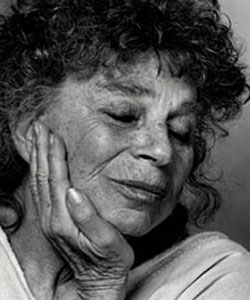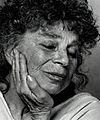Anna Halprin facts for kids
Quick facts for kids
Anna Halprin
|
|
|---|---|

Anna Halprin at the University of San Francisco, November 2010
|
|
| Born |
Hannah Dorothy Schuman
July 13, 1920 Winnetka, Illinois, U.S.
|
| Died | May 24, 2021 (aged 100) Kentfield, Marin County, California, U.S.
|
| Occupation | Dancer |
| Spouse(s) | Lawrence Halprin |
| Children | 2; including Daria Halprin |
| Current group | Tamalpa Institute |
| Dances | Postmodern dance |
Anna Halprin (born Hannah Dorothy Schuman; July 13, 1920 – May 24, 2021) was an American choreographer and dancer. She helped change dance in America after World War II. She was a pioneer of an experimental art form called postmodern dance. Anna Halprin saw herself as someone who broke the rules of traditional modern dance.
In the 1950s, she started the San Francisco Dancers' Workshop. This gave artists a place to explore new dance ideas. She developed a special way of moving by understanding her own body. With her husband, landscape architect Lawrence Halprin, she created the RSVP cycles. This was a creative method using "scores," which are like instructions. Many of her dances were scores, including Myths (1960s) where the audience became performers. Her Planetary Dance (1987) was also very interactive. Later in life, Anna Halprin became known for her work with people facing serious illnesses. She also used creative movement in nature.
In 1978, Anna Halprin and her daughter Daria Halprin founded the Tamalpa Institute. It is located in Marin County, California. The institute teaches their creative method called Life/Art process. Halprin wrote books like Movement Rituals and Dance as a Healing Art. A documentary film about her life, Breath Made Visible, came out in 2010.
Contents
Early Life and Dance Beginnings
Anna Halprin was born in Winnetka, Illinois. Her family was Jewish, and she was exposed to religious dancing from a young age. When she was four, her mother enrolled her in ballet. But Anna quickly found it too strict. Her mother then moved her to a class focused more on free movement. At age 15, Anna began studying the techniques of Ruth St. Denis and Isadora Duncan.
In 1938, she attended the University of Wisconsin–Madison. There, she studied with Margaret H'Doubler, who became a lifelong mentor. H'Doubler taught the importance of personal creativity. She also encouraged studying anatomy to understand how the body moves best. Halprin moved away from traditional modern dance styles. She wanted to create her own way of showing everyday life through movement. She used improvisation to explore how people could create together. This helped form the basis for the next generation's ideas of postmodern dance.
While in college, she met her husband, landscape architect Lawrence Halprin.
Starting the San Francisco Dancers' Workshop
After World War II, Lawrence Halprin's job brought them to San Francisco. Anna Halprin was ready for a new adventure. Lawrence built a dance deck outside their home. This deck became a place for Anna, her children, and her students to learn and create.
In the late 1940s, Halprin danced with Mimi Kagan as the San Francisco Dance League.
In 1955, after performing in New York, Halprin felt that many dancers looked too similar. She believed this stopped creativity. So, in 1959, Halprin founded the San Francisco Dancers' Workshop. Other artists joined her, including dancers Trisha Brown, Simone Forti, and Yvonne Rainer. The workshop aimed to explore new dance forms. It moved away from the strict rules of modern dance. For twenty years, she developed a process that allowed people to move freely. This technique focused on connecting non-verbal actions with physical expression. Halprin also continued to perform. She danced about "real life" in pieces like Apartment 6.
Understanding Movement: Kinesthetic Awareness and RSVP Cycles
Anna Halprin explored how to create her own movements. This meant understanding the body's limits and how it reacts. She described kinesthetic awareness as your special sense for knowing your own movement. It also helps you understand how others move. She created group exercises called Movement Rituals. These shaped how she and her students moved. Her movements were based on actions like swinging, falling, walking, running, and shifting weight.
In the 1960s, she added the RSVP Cycles to her work. Her husband, Lawrence Halprin, developed this method. It breaks down the creative process using "scores." RSVP stands for Resources, Scores, Valuaction, and Performance. Halprin wanted to create something where groups could explore a theme. She hoped this would help them discover what was real for them. She believed that formal scores, like the Planetary Dance, could spark creativity. The Planetary Dance involves three circles moving in different directions. Participants are told to run, walk, or stand still. Her training programs could last up to a year. They helped participants focus on moving each body part. Later, they learned to move the body as a whole.
Dance for Healing and Community
In 1972, Anna Halprin was diagnosed with cancer. This changed her life and inspired her to create a personal ritual for healing. She used tools she had learned to understand how emotions could be expressed in performances. Her illness also led her to express her feelings through dance, such as in Darkside Dance. After this, she stopped performing publicly.
Halprin wrote about her experiences and created "The Five Stages of Healing." In 1981, she used this process with her community. She believed that connecting with nature could change how we treat our environment and each other.
Her journey to heal encouraged those around her. In 1978, she co-founded the Tamalpa Institute with her daughter. This non-profit organization offers training in a creative process. It combines psychology, body therapies, and education with dance, art, and drama. The goal is to help people heal and solve social problems. Her "Life/Art Process" inspired workshops for therapeutic needs. She used movement, dialogue, voice, drawing, and improvisation. This helped others explore themselves and use art as a way to heal. Sometimes, participants return to the Mountain Home Studio. They dance on the deck where Halprin's journey first began.
In the 1970s and 1980s, she focused on working with people who were seriously ill. In 1987, she was invited to the Cancer Support and Education Center. There, she led people through body awareness exercises. She also had them create visualizations of themselves through art. These exercises helped them find energy. She continued to work with ill patients for many years. One important work she created was Circle the Earth in 1981. This dance was based on an open-ended score. It guided the group through a creative experience that ended in a performance. Halprin also began making dances about important social issues. She no longer wanted spectators just watching her work. Instead, she wanted people to realize the dancers had a purpose. They were there "to accomplish something in ourselves and the world." This is why her dances often had political messages.
Images for kids
See Also
- Postmodern dance
- Lawrence Halprin
- Tamalpa Institute



